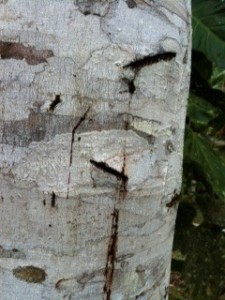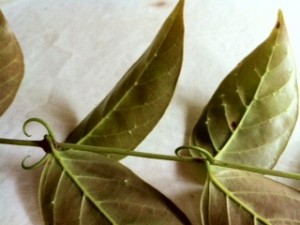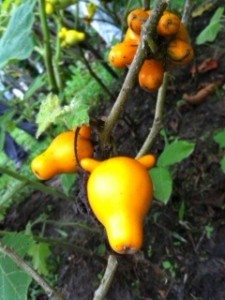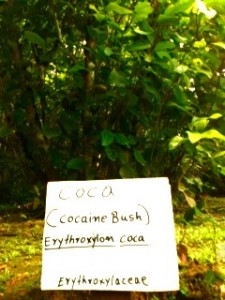The Explornapo Lodges provided a nice respite from the urban grime of Iquitos for the first weekend off from my work trip to Peru with Amazon Cares. This cluster of rustic, thatched roof huts featuring WiFi access and mosquito net encased beds is our home for four days as we will be offering veterinary services to remote communities along the Amazon River.
 As I frequently utilize herbs (Chinese) to treat my veterinary acupuncture patients, I was very interested in learning about the use of native plants to treat human illness at the Renu Peru Ethnobotanical Garden. A shaman gave us a very hands on lecture permitting us to smell, taste, and apply to our skin the variety of natural medicinal offerings.
The most notable included:
As I frequently utilize herbs (Chinese) to treat my veterinary acupuncture patients, I was very interested in learning about the use of native plants to treat human illness at the Renu Peru Ethnobotanical Garden. A shaman gave us a very hands on lecture permitting us to smell, taste, and apply to our skin the variety of natural medicinal offerings.
The most notable included:
 Sangre de Grado (Dragon's Blood) This unique plant produces a red sap that emulsifies into a white paste when rubbed onto the skin and is used as an anti-inflammatory to treat insect bites, acne, and psoriasis. Considering the extreme insect burden which we must avoid in the jungle, Dragon's Blood has been rather useful. When the tree is cut, the deep crimson sap leaks out and lends the appearance of a slasher movie's unfortunate victim.
Una de Gato (Cat's Claw) I already had experience using Standard Process' version in my veterinary practice for cancer patients, as it is a powerful anti-oxidant and anti-inflammatory. Therefore, I was very enthused to see Cat's Claw in its natural form. The plant gets it's name from the unique shape, which truly appears like a feline's keratinized scratcher.
Sangre de Grado (Dragon's Blood) This unique plant produces a red sap that emulsifies into a white paste when rubbed onto the skin and is used as an anti-inflammatory to treat insect bites, acne, and psoriasis. Considering the extreme insect burden which we must avoid in the jungle, Dragon's Blood has been rather useful. When the tree is cut, the deep crimson sap leaks out and lends the appearance of a slasher movie's unfortunate victim.
Una de Gato (Cat's Claw) I already had experience using Standard Process' version in my veterinary practice for cancer patients, as it is a powerful anti-oxidant and anti-inflammatory. Therefore, I was very enthused to see Cat's Claw in its natural form. The plant gets it's name from the unique shape, which truly appears like a feline's keratinized scratcher.
 Breast Berry One may think this plant's name is derived from the bulbous protrusions emanating from the central portion (I did). Actually, Breast Berry is termed so due to it's resemblance to the bovine udder (i.e., the cow's breasts). It is used for the treatment of scabies and acts as a colorful decoy to attract animals from eating plants having more significant treatment properties.
Breast Berry One may think this plant's name is derived from the bulbous protrusions emanating from the central portion (I did). Actually, Breast Berry is termed so due to it's resemblance to the bovine udder (i.e., the cow's breasts). It is used for the treatment of scabies and acts as a colorful decoy to attract animals from eating plants having more significant treatment properties. Our session concluded with the opportunity for the Amazon Cares volunteers to participate in a shaman ceremony in groups of three. Dr V (Jessica Vogelsang), Katherine Mock, and I all sat through a ten minute long ritual of chants, pat downs with leaves, and medicinal smoke annointments. It was very reminiscent of the sweat lodge I endured through a few years back during yoga teacher training at Feather Pipe Ranch in Montana, yet it was more enjoyable.
Our session concluded with the opportunity for the Amazon Cares volunteers to participate in a shaman ceremony in groups of three. Dr V (Jessica Vogelsang), Katherine Mock, and I all sat through a ten minute long ritual of chants, pat downs with leaves, and medicinal smoke annointments. It was very reminiscent of the sweat lodge I endured through a few years back during yoga teacher training at Feather Pipe Ranch in Montana, yet it was more enjoyable.
 Feeling spiritually cleansed, I toured the garden of medicinal plants to discover one species that some people may have sampled at a party in the 80s. It's legal for me to bring the bagged tea version back to the states, so each stimulating sip will fondly remind me of my sweaty vets abroad experience in Peru.
Feeling spiritually cleansed, I toured the garden of medicinal plants to discover one species that some people may have sampled at a party in the 80s. It's legal for me to bring the bagged tea version back to the states, so each stimulating sip will fondly remind me of my sweaty vets abroad experience in Peru. As one-fourth of the world's manufactured prescription medications have their chemical origins in plants, we need to do our best to protect the vast resources of the jungle so that beneficial plant derived compounds can be discovered. Your health and that of your pets may depend on it. Please do your best to live a conservational lifestyle by reducing your waste production through recycling, turning off the water when you shave, and other means.
Please help Amazon Cares continue to make grounds in enhancing the health of dogs and cats in Peru by making a tax deductible donation to their cause. As I am donating my time, experience, and labor to Amazon Cares, the other volunteers and I would appreciate your financial aid.
Thank you to i Love Dogs premium canine supplements for your premiere sponsorship of our vets abroad trip into the Amazon Jungle in the name of animal welfare.
Thank you for reading my article. To receive my next update of my trip to Peru via email, please press the “Don’t Miss a Blog Post” button on the right upper corner of this page or follow this link.
Make sure to follow my Amazon Cares adventures by friending Patrick Mahaney: Veterinarian Acupuncture Pain Management for Your Pets on Facebook and @PatrickMahaney on Twitter.
Copyright of this article (2011) is owned by Dr. Patrick Mahaney, Veterinarian and Certified Veterinary Acupuncturist. Republishing any portion of this article must first be authorized by Dr. Patrick Mahaney. Requests for republishing must be approved by Dr. Patrick Mahaney and received in written format.
As one-fourth of the world's manufactured prescription medications have their chemical origins in plants, we need to do our best to protect the vast resources of the jungle so that beneficial plant derived compounds can be discovered. Your health and that of your pets may depend on it. Please do your best to live a conservational lifestyle by reducing your waste production through recycling, turning off the water when you shave, and other means.
Please help Amazon Cares continue to make grounds in enhancing the health of dogs and cats in Peru by making a tax deductible donation to their cause. As I am donating my time, experience, and labor to Amazon Cares, the other volunteers and I would appreciate your financial aid.
Thank you to i Love Dogs premium canine supplements for your premiere sponsorship of our vets abroad trip into the Amazon Jungle in the name of animal welfare.
Thank you for reading my article. To receive my next update of my trip to Peru via email, please press the “Don’t Miss a Blog Post” button on the right upper corner of this page or follow this link.
Make sure to follow my Amazon Cares adventures by friending Patrick Mahaney: Veterinarian Acupuncture Pain Management for Your Pets on Facebook and @PatrickMahaney on Twitter.
Copyright of this article (2011) is owned by Dr. Patrick Mahaney, Veterinarian and Certified Veterinary Acupuncturist. Republishing any portion of this article must first be authorized by Dr. Patrick Mahaney. Requests for republishing must be approved by Dr. Patrick Mahaney and received in written format.
 As I frequently utilize herbs (Chinese) to treat my veterinary acupuncture patients, I was very interested in learning about the use of native plants to treat human illness at the Renu Peru Ethnobotanical Garden. A shaman gave us a very hands on lecture permitting us to smell, taste, and apply to our skin the variety of natural medicinal offerings.
The most notable included:
As I frequently utilize herbs (Chinese) to treat my veterinary acupuncture patients, I was very interested in learning about the use of native plants to treat human illness at the Renu Peru Ethnobotanical Garden. A shaman gave us a very hands on lecture permitting us to smell, taste, and apply to our skin the variety of natural medicinal offerings.
The most notable included:
 Sangre de Grado (Dragon's Blood) This unique plant produces a red sap that emulsifies into a white paste when rubbed onto the skin and is used as an anti-inflammatory to treat insect bites, acne, and psoriasis. Considering the extreme insect burden which we must avoid in the jungle, Dragon's Blood has been rather useful. When the tree is cut, the deep crimson sap leaks out and lends the appearance of a slasher movie's unfortunate victim.
Una de Gato (Cat's Claw) I already had experience using Standard Process' version in my veterinary practice for cancer patients, as it is a powerful anti-oxidant and anti-inflammatory. Therefore, I was very enthused to see Cat's Claw in its natural form. The plant gets it's name from the unique shape, which truly appears like a feline's keratinized scratcher.
Sangre de Grado (Dragon's Blood) This unique plant produces a red sap that emulsifies into a white paste when rubbed onto the skin and is used as an anti-inflammatory to treat insect bites, acne, and psoriasis. Considering the extreme insect burden which we must avoid in the jungle, Dragon's Blood has been rather useful. When the tree is cut, the deep crimson sap leaks out and lends the appearance of a slasher movie's unfortunate victim.
Una de Gato (Cat's Claw) I already had experience using Standard Process' version in my veterinary practice for cancer patients, as it is a powerful anti-oxidant and anti-inflammatory. Therefore, I was very enthused to see Cat's Claw in its natural form. The plant gets it's name from the unique shape, which truly appears like a feline's keratinized scratcher.
 Breast Berry One may think this plant's name is derived from the bulbous protrusions emanating from the central portion (I did). Actually, Breast Berry is termed so due to it's resemblance to the bovine udder (i.e., the cow's breasts). It is used for the treatment of scabies and acts as a colorful decoy to attract animals from eating plants having more significant treatment properties.
Breast Berry One may think this plant's name is derived from the bulbous protrusions emanating from the central portion (I did). Actually, Breast Berry is termed so due to it's resemblance to the bovine udder (i.e., the cow's breasts). It is used for the treatment of scabies and acts as a colorful decoy to attract animals from eating plants having more significant treatment properties. Our session concluded with the opportunity for the Amazon Cares volunteers to participate in a shaman ceremony in groups of three. Dr V (Jessica Vogelsang), Katherine Mock, and I all sat through a ten minute long ritual of chants, pat downs with leaves, and medicinal smoke annointments. It was very reminiscent of the sweat lodge I endured through a few years back during yoga teacher training at Feather Pipe Ranch in Montana, yet it was more enjoyable.
Our session concluded with the opportunity for the Amazon Cares volunteers to participate in a shaman ceremony in groups of three. Dr V (Jessica Vogelsang), Katherine Mock, and I all sat through a ten minute long ritual of chants, pat downs with leaves, and medicinal smoke annointments. It was very reminiscent of the sweat lodge I endured through a few years back during yoga teacher training at Feather Pipe Ranch in Montana, yet it was more enjoyable.
 Feeling spiritually cleansed, I toured the garden of medicinal plants to discover one species that some people may have sampled at a party in the 80s. It's legal for me to bring the bagged tea version back to the states, so each stimulating sip will fondly remind me of my sweaty vets abroad experience in Peru.
Feeling spiritually cleansed, I toured the garden of medicinal plants to discover one species that some people may have sampled at a party in the 80s. It's legal for me to bring the bagged tea version back to the states, so each stimulating sip will fondly remind me of my sweaty vets abroad experience in Peru. As one-fourth of the world's manufactured prescription medications have their chemical origins in plants, we need to do our best to protect the vast resources of the jungle so that beneficial plant derived compounds can be discovered. Your health and that of your pets may depend on it. Please do your best to live a conservational lifestyle by reducing your waste production through recycling, turning off the water when you shave, and other means.
Please help Amazon Cares continue to make grounds in enhancing the health of dogs and cats in Peru by making a tax deductible donation to their cause. As I am donating my time, experience, and labor to Amazon Cares, the other volunteers and I would appreciate your financial aid.
Thank you to i Love Dogs premium canine supplements for your premiere sponsorship of our vets abroad trip into the Amazon Jungle in the name of animal welfare.
Thank you for reading my article. To receive my next update of my trip to Peru via email, please press the “Don’t Miss a Blog Post” button on the right upper corner of this page or follow this link.
Make sure to follow my Amazon Cares adventures by friending Patrick Mahaney: Veterinarian Acupuncture Pain Management for Your Pets on Facebook and @PatrickMahaney on Twitter.
Copyright of this article (2011) is owned by Dr. Patrick Mahaney, Veterinarian and Certified Veterinary Acupuncturist. Republishing any portion of this article must first be authorized by Dr. Patrick Mahaney. Requests for republishing must be approved by Dr. Patrick Mahaney and received in written format.
As one-fourth of the world's manufactured prescription medications have their chemical origins in plants, we need to do our best to protect the vast resources of the jungle so that beneficial plant derived compounds can be discovered. Your health and that of your pets may depend on it. Please do your best to live a conservational lifestyle by reducing your waste production through recycling, turning off the water when you shave, and other means.
Please help Amazon Cares continue to make grounds in enhancing the health of dogs and cats in Peru by making a tax deductible donation to their cause. As I am donating my time, experience, and labor to Amazon Cares, the other volunteers and I would appreciate your financial aid.
Thank you to i Love Dogs premium canine supplements for your premiere sponsorship of our vets abroad trip into the Amazon Jungle in the name of animal welfare.
Thank you for reading my article. To receive my next update of my trip to Peru via email, please press the “Don’t Miss a Blog Post” button on the right upper corner of this page or follow this link.
Make sure to follow my Amazon Cares adventures by friending Patrick Mahaney: Veterinarian Acupuncture Pain Management for Your Pets on Facebook and @PatrickMahaney on Twitter.
Copyright of this article (2011) is owned by Dr. Patrick Mahaney, Veterinarian and Certified Veterinary Acupuncturist. Republishing any portion of this article must first be authorized by Dr. Patrick Mahaney. Requests for republishing must be approved by Dr. Patrick Mahaney and received in written format.